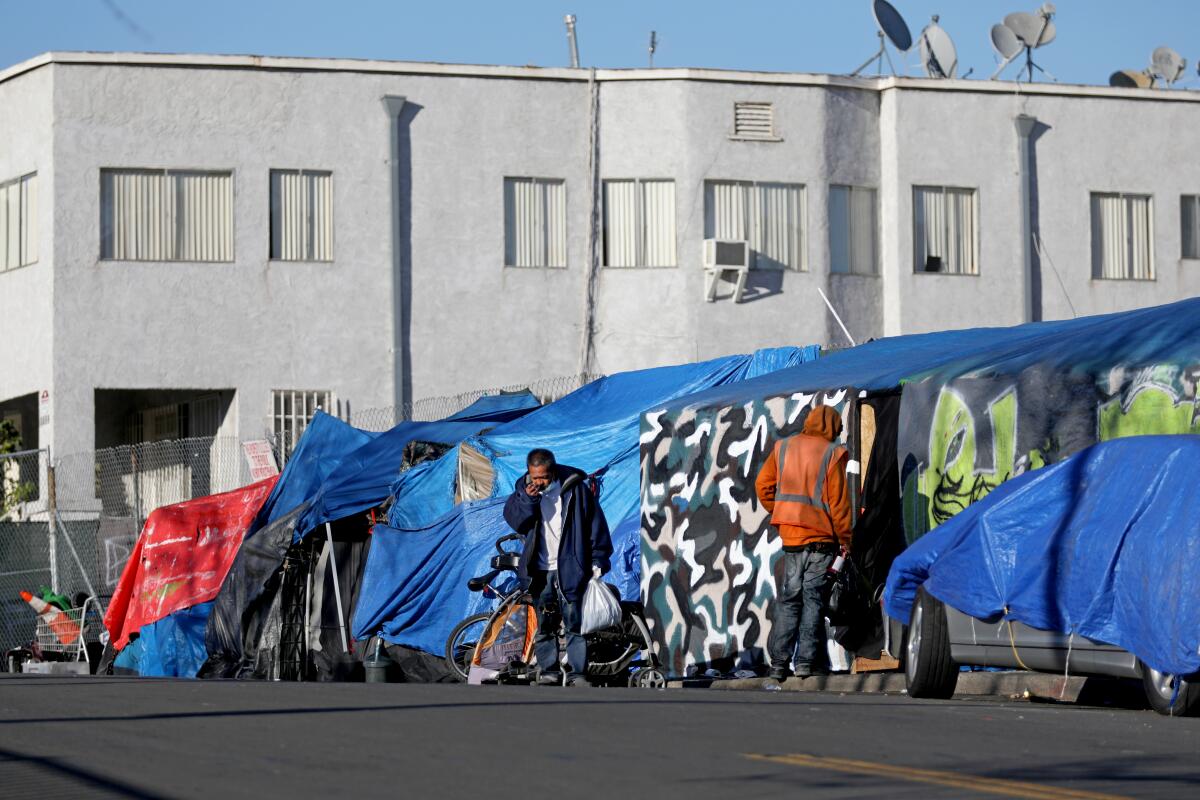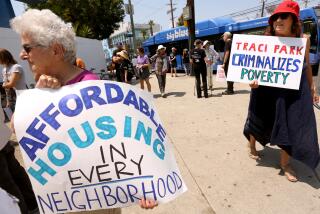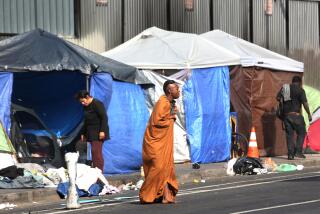Op-Ed: What we should have learned from L.A.’s long history of homelessness

Los Angeles Mayor Eric Garcetti’s campaign to “end homelessness” by 2028 — which has cost about $200 million in building shelters around the city — addresses some of the structural pitfalls ensnaring the poor.
But it is far from living up to its promise of moving homeless Angelenos off the streets into permanent housing. Recent data show that of nearly 1,500 people who were in the shelters and left in November, only 15% moved to permanent housing. Two-thirds either went back to the streets or did not indicate where they were going.
Though the city’s ambitious initiative offers some ways to support a population often seen as desperate and helpless, it omits a crucial factor from the policy discussion: the self-determination of unhoused people. This is a force that has played out on the streets of L.A. for over a century. And recognizing this reality will be key to advancing durable solutions to a crisis of material deprivation and human rights.
During the 1930s, thousands of Americans abandoned or were evicted from their homes, hitting the road to look for work, often far from their home communities. Los Angeles was inundated by migrants and scrambled to respond to the deluge of homelessness. The city had no public shelters, while private institutions offered no long-term accommodations in their cramped facilities. An undercover social worker of the time revealed draconian rules and humiliating treatment that made private shelters repellent to people seeking housing.
Without enough shelters and a dogged commitment to deterring migration, state authorities established rural camps throughout California. Homeless men, many driven by severe hunger, labored as firefighters in exchange for food, clothing and lodging. They received no wages for their labor.
But this is not the end of the story. Homeless people pressed for alternatives. An enterprising band styling themselves the Organized Homeless Youth of Los Angeles petitioned the county’s welfare department to rent them a house in South-Central L.A. Offered spots in one of the city’s six labor camps instead, the group defiantly occupied their chosen home anyway.
This was not unique to Los Angeles. Across the nation, unhoused single men and families founded encampments, satirically calling them “Hoovervilles” as a jab at President Hoover’s austere response to the economic crisis.
One such encampment — the Florence-Graham “Hoover Town” — housed families in South L.A. Residents built impressive one-room homes from scraps of wood, cardboard, corrugated metal, canvas and automobile parts. In 1940, government officials burned the encampment to the ground.
After World War II, cities nationwide, including Los Angeles, launched “urban renewal” projects razing and rebuilding downtowns and ramming freeways through redlined neighborhoods, worsening the already dire postwar housing crisis. Legions of predominantly Black and brown working-class households were displaced. As the housing stock dwindled, so too did the supply of good-paying jobs, leading many from those communities to skid row’s social service providers and single-room-occupancy hotels. Others ended up on the street.
Ignoring the deep structural causes of homelessness, local officials deemed this population a threat to downtown property values and sought to expel it. Ramping up enforcement of vaguely defined public order infractions, such as loitering, and aggressively targeting skid row hotels for building code violations, the city sought to clear out precariously housed people with force.
But unlike nearly every other American city embarking on skid row redevelopment in the postwar era, Los Angeles did not succeed. By the mid-1970s, city officials and activists compromised on a “containment” plan that conceded skid row as a home for unhoused people. That historical agreement is part of a longer story in which the poor and unhoused of Los Angeles have consistently resisted government efforts to remove them from the city, whether into jails, camps or highly restrictive shelters.
What does this history teach us? First, that homeless people are actors and make decisions on their own behalf that city policy cannot fully control. Second, it urges us to take steps to support their self-determination.
That means advancing grass-roots homebuilding initiatives, like the L.A. Community Action Network’s EcoHood project, which envisions sustainably constructed micro homes on vacant or underutilized government-owned land. It also means ensuring access to water, bathrooms, trash collection and other vital services in existing encampments. Simply removing them can be devastating for the people who live there and certainly detrimental to solving the crisis. Without dignified and healthful alternatives, encampments will continue to serve as homes for thousands of marginalized people, as they have now for over a century.
Marques Vestal is an incoming assistant professor in the Department of Urban Planning at UCLA. Andrew Klein is a PhD candidate in history at UCLA. They are members of the research team that produced the newly released report “The Making of a Crisis: A History of Homelessness in Los Angeles” for the UCLA Luskin Center for History and Policy.
More to Read
A cure for the common opinion
Get thought-provoking perspectives with our weekly newsletter.
You may occasionally receive promotional content from the Los Angeles Times.










